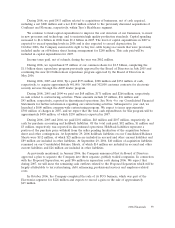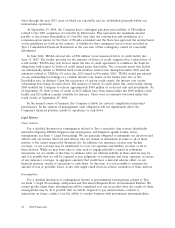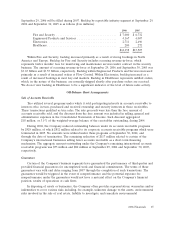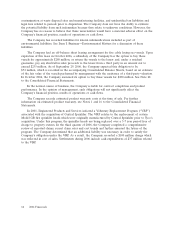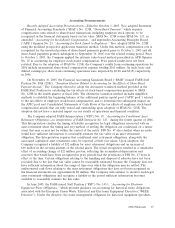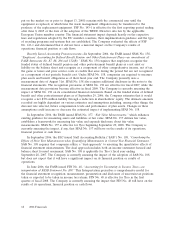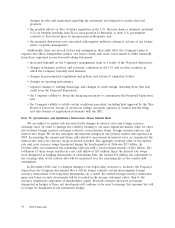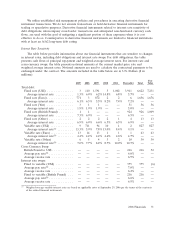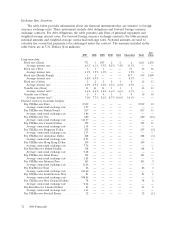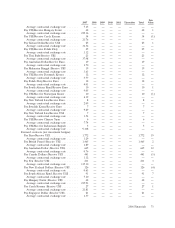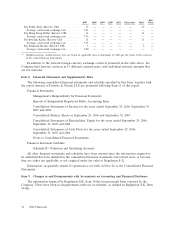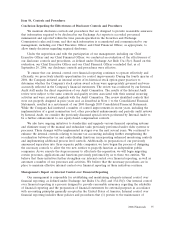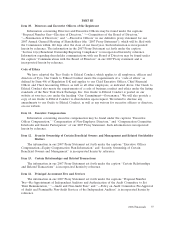ADT 2006 Annual Report Download - page 129
Download and view the complete annual report
Please find page 129 of the 2006 ADT annual report below. You can navigate through the pages in the report by either clicking on the pages listed below, or by using the keyword search tool below to find specific information within the annual report.Accounting Pronouncements
Recently Adopted Accounting Pronouncements—Effective October 1, 2005, Tyco adopted Statement
of Financial Accounting Standards (‘‘SFAS’’) No. 123R, ‘‘Share-Based Payment,’’ which requires
compensation costs related to share-based transactions, including employee stock options, to be
recognized in the financial statements based on fair value. SFAS No. 123R revises SFAS No. 123, as
amended, ‘‘Accounting for Stock-Based Compensation,’’ and supersedes Accounting Principles Board
(‘‘APB’’) Opinion No. 25, ‘‘Accounting for Stock Issued to Employees.’’ Tyco adopted SFAS No. 123R
using the modified prospective application transition method. Under this method, compensation cost is
recognized for the unvested portion of share-based payments granted prior to October 1, 2005 and all
share-based payments granted subsequent to September 30, 2005 over the related vesting period. Prior
to October 1, 2005, the Company applied the intrinsic value based method prescribed in APB Opinion
No. 25 in accounting for employee stock-based compensation. Prior period results have not been
restated. Due to the adoption of SFAS No. 123R, the Company’s results from continuing operations for
2006 include incremental share-based compensation expense totaling $161 million. As such, basic and
diluted earnings per share from continuing operations were impacted by $0.06 and $0.05, respectively,
in 2006.
On November 10, 2005, the Financial Accounting Standards Board (‘‘FASB’’) issued FASB Staff
Position No. FAS 123R-3, ‘‘Transition Election Related to Accounting for Tax Effects of Share-Based
Payment Awards.’’ The Company elected to adopt the alternative transition method provided in the
FASB Staff Position for calculating the tax effects of stock-based compensation pursuant to SFAS
No. 123R in the fourth quarter of fiscal 2006. The alternative transition method includes simplified
methods to establish the beginning balance of the additional paid-in capital pool (‘‘APIC pool’’) related
to the tax effects of employee stock-based compensation, and to determine the subsequent impact on
the APIC pool and Consolidated Statements of Cash Flows of the tax effects of employee stock-based
compensation awards that are fully vested and outstanding upon adoption of SFAS No. 123R. The
adoption did not have a material impact on our results of operations and financial condition.
The Company adopted FASB Interpretation (‘‘FIN’’) No. 47, ‘‘Accounting for Conditional Asset
Retirement Obligations—an interpretation of FASB Statement No. 143,’’ during the fourth quarter of 2006.
This Interpretation clarifies the timing of liability recognition for legal obligations associated with an
asset retirement when the timing and (or) method of settling the obligation are conditional on a future
event that may or may not be within the control of the entity. FIN No. 47 also clarifies when an entity
would have sufficient information to reasonably estimate the fair value of an asset retirement
obligation. The Interpretation requires that conditional asset retirement obligations, along with the
associated capitalized asset retirement costs, be reported at their fair values. Upon adoption, the
Company recognized a liability of $32 million for asset retirement obligations and an increase of
$10 million in the carrying amount of the related assets. The initial recognition resulted in a cumulative
effect of accounting change of $22 million, pre-tax, reflecting the accumulated depreciation and
accretion that would have been recognized in prior periods had the provisions of FIN No. 47 been in
effect at the time. Certain obligations relating to the handling and disposal of asbestos have not been
recorded due to the fact that fair value cannot be reasonably estimated because the Company does not
have sufficient information about the range of time over which the obligation may be settled. The
undiscounted cash flows relating to the asset retirement obligations that have not been recognized in
the financial statements are approximately $8 million. The Company will continue to monitor such legal
asset retirement obligations and recognize a liability in the period sufficient information becomes
available to reasonably estimate the fair value.
In June 2005, the FASB issued Staff Position (‘‘FSP’’) No. 143-1, ‘‘Accounting for Electronic
Equipment Waste Obligations,’’ which provides guidance on accounting for historical waste obligations
associated with the European Union Waste, Electrical and Electronic Equipment Directive (‘‘WEEE
Directive’’). Under the directive, the waste management obligation for historical equipment (products
2006 Financials 67




